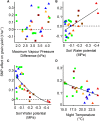Genome-Wide Analysis of Yield in Europe: Allelic Effects Vary with Drought and Heat Scenarios
- PMID: 27436830
- PMCID: PMC5047082
- DOI: 10.1104/pp.16.00621
Genome-Wide Analysis of Yield in Europe: Allelic Effects Vary with Drought and Heat Scenarios
Abstract
Assessing the genetic variability of plant performance under heat and drought scenarios can contribute to reduce the negative effects of climate change. We propose here an approach that consisted of (1) clustering time courses of environmental variables simulated by a crop model in current (35 years × 55 sites) and future conditions into six scenarios of temperature and water deficit as experienced by maize (Zea mays L.) plants; (2) performing 29 field experiments in contrasting conditions across Europe with 244 maize hybrids; (3) assigning individual experiments to scenarios based on environmental conditions as measured in each field experiment; frequencies of temperature scenarios in our experiments corresponded to future heat scenarios (+5°C); (4) analyzing the genetic variation of plant performance for each environmental scenario. Forty-eight quantitative trait loci (QTLs) of yield were identified by association genetics using a multi-environment multi-locus model. Eight and twelve QTLs were associated to tolerances to heat and drought stresses because they were specific to hot and dry scenarios, respectively, with low or even negative allelic effects in favorable scenarios. Twenty-four QTLs improved yield in favorable conditions but showed nonsignificant effects under stress; they were therefore associated with higher sensitivity. Our approach showed a pattern of QTL effects expressed as functions of environmental variables and scenarios, allowing us to suggest hypotheses for mechanisms and candidate genes underlying each QTL. It can be used for assessing the performance of genotypes and the contribution of genomic regions under current and future stress situations and to accelerate breeding for drought-prone environments.
© 2016 American Society of Plant Biologists. All Rights Reserved.
Figures







References
-
- Allen RG, Pereira LS, Raes D, Smith M (1998) Crop evapotranspiration: guidelines for computing crop water requirements. Food and Agriculture Organization of the United Nations, Rome
-
- Basu D, Tian L, Debrosse T, Poirier E, Emch K, Herock H, Travers A, Showalter AM (2016) Glycosylation of a Fasciclin-Like Arabinogalactan-Protein (SOS5) Mediates Root Growth and Seed Mucilage Adherence via a Cell Wall Receptor-Like Kinase (FEI1/FEI2) Pathway in Arabidopsis. PLoS One 11: e0145092. - PMC - PubMed
-
- Bishop KA, Betzelberger AM, Long SP, Ainsworth EA (2015) Is there potential to adapt soybean (Glycine max Merr.) to future [CO2]? An analysis of the yield response of 18 genotypes in free-air CO2 enrichment: Variation in soybean response to elevated. CO2. Plant Cell Environ 38: 1765–1774 - PubMed
-
- Boer MP, Wright D, Feng L, Podlich DW, Luo L, Cooper M, van Eeuwijk FA (2007) A mixed-model quantitative trait loci (QTL) analysis for multiple-environment trial data using environmental covariables for QTL-by-environment interactions, with an example in maize. Genetics 177: 1801–1813 - PMC - PubMed
-
- Bonneau J, Taylor J, Parent B, Bennett D, Reynolds M, Feuillet C, Langridge P, Mather D (2013) Multi-environment analysis and improved mapping of a yield-related QTL on chromosome 3B of wheat. Theor Appl Genet 126: 747–761 - PubMed
Publication types
MeSH terms
LinkOut - more resources
Full Text Sources
Other Literature Sources

